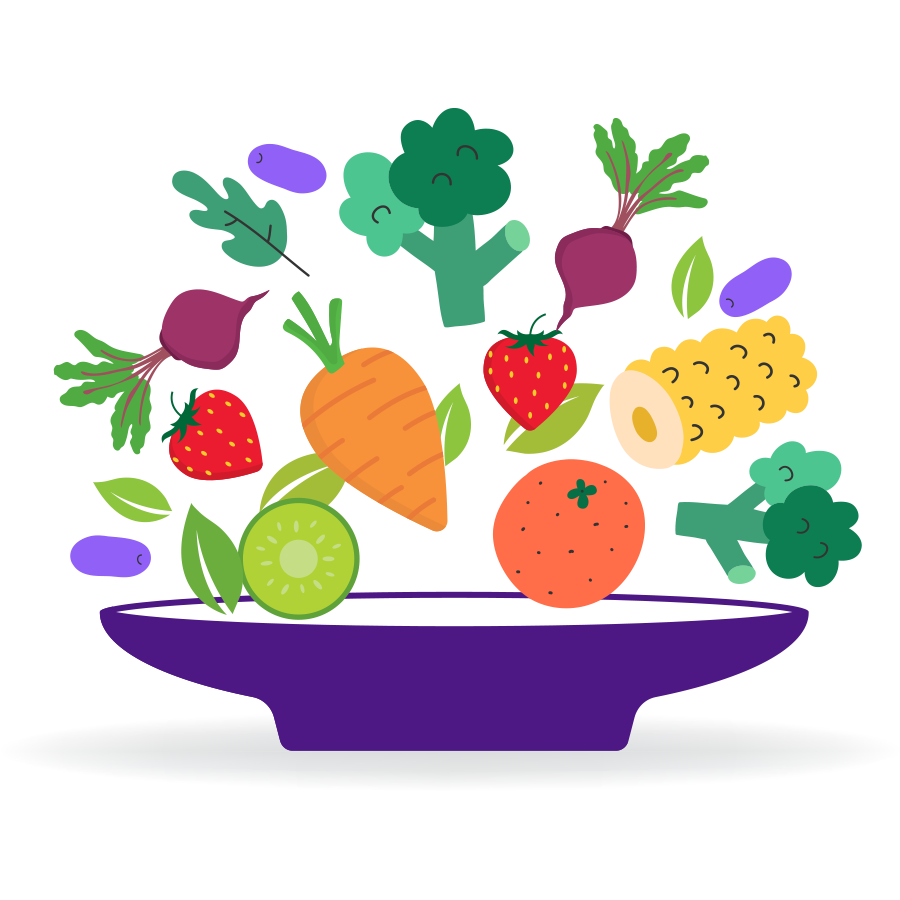You already know that a diet that includes fruit and veg is important, but what are the real benefits of eating the rainbow: something red, green... or purple?
Plants contain different pigments, or phytonutrients, which give them their colour. Different-coloured plants are linked to higher levels of specific nutrients and health benefits.
A simple habit that’s easy to keep is simply mixing up the colours of fruit and veg that you eat. A green leaf here, a carrot there, a few red grapes for dessert. It all adds up to a healthier you!

Red:
Red foods such as tomatoes, red peppers, and strawberries are rich in lycopene. One of the biggest benefits of lycopene is that it is an antioxidant and protects the body from free radical stress that can damage DNA and other cell structures. The antioxidant properties help balance free radical activity in the body and, in doing so, may reduce the risk of certain diseases. For example, there's emerging evidence that lycopene has a role in supporting heart health.
Main phytonutrients:
Lycopene (Vitamin A family)
Main vitamins and minerals:
Folate
Potassium
Vitamins A, C and K1
Some of the potential health benefits:
Anti-inflammatory
Antioxidant
May benefit heart health

Orange/Yellow:
Orange and yellow fruits and vegetables like carrots, sweet potatoes, and mangoes are high in beta-carotene, which the body converts into vitamin A. Vitamin A is important for maintaining healthy skin, eyes, and immune system function. These foods may also contain vitamin C and other antioxidants, as well as potassium and fibre, which can improve digestion and heart health.
Main phytonutrients:
Carotenoids (e.g., beta carotene, alpha carotene, which belong to the vitamin A family)
Main vitamins and minerals:
Fibre
Folate
Potassium
Vitamin A (beta carotene), C
Some of the potential health benefits:
Anti-inflammatory
Antioxidant
May benefit heart health
Supports eye health

Green:
Green leafy vegetables like kale, spinach, and broccoli are packed with vitamins and minerals, including vitamins A, C, and K, as well as folate, iron, and calcium. They're also high in antioxidants like lutein and zeaxanthin, which may help protect against eye diseases. Cruciferous vegetables like broccoli and cauliflower are rich in vitamins and minerals such as folate and vitamin K. Dark green cruciferous veggies also are a source of vitamins A and C and contain phytonutrients — plant-based compounds that may help to lower inflammation.
Main phytonutrients:
Leafy greens: chlorophyll and carotenoids
Cruciferous greens (e.g., broccoli, cabbage): indoles, isothiocyanates, glucosinolates
Main vitamins and minerals:
Fibre
Folate
Magnesium
Potassium
Vitamins A, K1
Some of the potential health benefits:
Anti-inflammatory
Antioxidant
May lower risk of heart disease

Blue and purple:
Blue and purple foods like haskap berries, plums and aubergines contain anthocyanins, which some studies show may help improve brain function and reduce inflammation. These foods are also rich in antioxidants like vitamin C, as well as fibre and potassium. Some studies suggest that eating blue and purple fruits and vegetables may also lower the risk of heart disease. For more detailed information on the power of purple foods, click here.
Main phytonutrients:
Anthocyanins
Main vitamins and minerals:
Fibre
Manganese
Potassium
Vitamins A, B6, C, K1
Some of the potential health benefits:
Anti-inflammatory
Antioxidant
May benefit heart health
May benefit brain function
May improve sports recovery
And now for the Haskapa bit!
You can get all the blue, red and purple anthocyanins your body needs with 1-2 teaspoons a day of haskap berry powder.
It’s the equivalent of eating a handful of fresh berries a day and best of all, tastes amazingly tangy and sweet, which the whole family will love.


